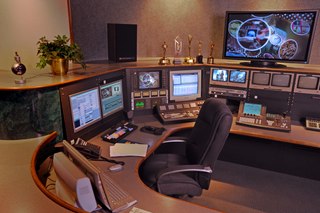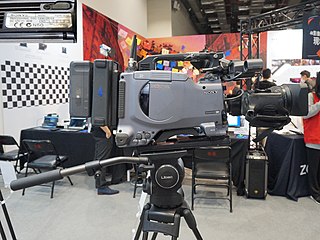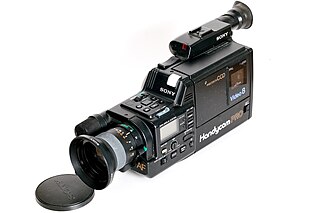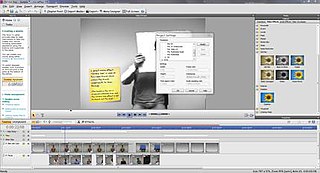Related Research Articles

Video editing software, or a video editor is software used for performing the post-production video editing of digital video sequences on a non-linear editing system (NLE). It has replaced traditional flatbed celluloid film editing tools and analog video tape editing machines.

DV is a family of codecs and tape formats used for storing digital video, launched in 1995 by a consortium of video camera manufacturers led by Sony and Panasonic. It includes the recording or cassette formats DV, MiniDV, DVCAM, Digital8, HDV, DVCPro, DVCPro50 and DVCProHD. DV has been used primarily for video recording with camcorders in the amateur and professional sectors.

Non-linear editing is a form of offline editing for audio, video, and image editing. In offline editing, the original content is not modified in the course of editing. In non-linear editing, edits are specified and modified by specialized software. A pointer-based playlist, effectively an edit decision list (EDL), for video and audio, or a directed acyclic graph for still images, is used to keep track of edits. Each time the edited audio, video, or image is rendered, played back, or accessed, it is reconstructed from the original source and the specified editing steps. Although this process is more computationally intensive than directly modifying the original content, changing the edits themselves can be almost instantaneous, and it prevents further generation loss as the audio, video, or image is edited.

Videotape is magnetic tape used for storing video and usually sound in addition. Information stored can be in the form of either an analog or digital signal. Videotape is used in both video tape recorders (VTRs) and, more commonly, videocassette recorders (VCRs) and camcorders. Videotapes have also been used for storing scientific or medical data, such as the data produced by an electrocardiogram.

Post-production is part of the process of filmmaking, video production, audio production, and photography. Post-production includes all stages of production occurring after principal photography or recording individual program segments.
A hard disk recorder (HDR) is a system that uses a high-capacity hard disk to record digital audio or digital video. Hard disk recording systems represent an alternative to reel-to-reel audio tape recording and video tape recorders, and provide non-linear editing capabilities unavailable using tape recorders. Audio HDR systems, which can be standalone or computer-based, are typically combined with provisions for digital mixing and processing of the audio signal to produce a digital audio workstation (DAW).

A camcorder is a self-contained portable electronic device with video and recording as its primary function. It is typically equipped with an articulating screen mounted on the left side, a belt to facilitate holding on the right side, hot-swappable battery facing towards the user, hot-swappable recording media, and an internally contained quiet optical zoom lens.
A digital video recorder (DVR) is an electronic device that records video in a digital format to a disk drive, USB flash drive, SD memory card, SSD or other local or networked mass storage device. The term includes set-top boxes with direct to disk recording, portable media players and TV gateways with recording capability, and digital camcorders. Personal computers are often connected to video capture devices and used as DVRs; in such cases the application software used to record video is an integral part of the DVR. Many DVRs are classified as consumer electronic devices; such devices may alternatively be referred to as personal video recorders (PVRs), particularly in Canada. Similar small devices with built-in displays and SSD support may be used for professional film or video production, as these recorders often do not have the limitations that built-in recorders in cameras have, offering wider codec support, the removal of recording time limitations and higher bitrates.

Magnetic storage or magnetic recording is the storage of data on a magnetized medium. Magnetic storage uses different patterns of magnetisation in a magnetizable material to store data and is a form of non-volatile memory. The information is accessed using one or more read/write heads.

HDV is a format for recording of high-definition video on DV videocassette tape. The format was originally developed by JVC and supported by Sony, Canon, and Sharp. The four companies formed the HDV Consortium in September 2003.
Editcam is a professional digital camera system manufactured by Ikegami and first introduced in 1995, available both as professional camcorders and modular dock recorders. It is the first ever tapeless field acquisition device and has evolved into a range of SD and HD cameras. As a portable camera system, it can record digital video data direct to a hard disk drive.

XDCAM is a series of products for digital recording using random access solid-state memory media, introduced by Sony in 2003. Four different product lines – the XDCAM SD, XDCAM HD, XDCAM EX and XDCAM HD422 – differ in types of encoder used, frame size, container type and in recording media.

P2 is a professional digital recording solid-state memory storage media format introduced by Panasonic in 2004. The P2 card is essentially a RAID of Secure Digital (SD) memory cards with an LSI controller tightly packaged in a die-cast PC Card enclosure. The system includes cameras, decks as drop-in replacements for videotape decks, and a special 5.25-inch computer drive for random-access integration with non-linear editing systems (NLE). The cards can also be used directly where a PC card (PCMCIA) slot is available, as in most older notebook computers, as a normal hard disk drive, although a custom software driver must first be loaded.
Offline editing is the creative storytelling stage of film making and television production where the structure, mood, pacing and story of the final show are defined. Many versions and revisions are presented and considered at this stage until the edit gets to a stage known as picture lock. This is when the process then moves on to the next stages of post production known as online editing, colour grading and audio mixing.
Digital audio cassette formats introduced to the professional audio and consumer markets:

Sony Corporation produces professional, consumer, and prosumer camcorders such as studio and broadcast, digital cinema cameras, camcorders, pan-tilt-zoom and remote cameras.

Serif MoviePlus was a non-linear video editor created by Serif Europe that allowed both professional and home users to edit digital video and digital images.
The JVC GZ-MG555 camcorder, also known as the JVC GZ-MG575, was produced by JVC in 2007. It records standard definition MPEG-2 video onto either a built-in hard disk drive or on a secure digital memory card in MOD format.
MOD and TOD are recording formats for use in digital tapeless camcorders. The formats are comparable to XDCAM EX, HDV and AVCHD.
In the field of professional broadcasting, an end-to-end workflow is called tapeless when part, or all of it, is made without any use of audio tape recorders or videotape machines; video and audio sources being ingested, recorded, edited and played out entirely on digital video systems.
References
- ↑ Bill Davis (March 2006). "Saving Time: Editing Tapeless". Videomaker Magazine. Videomaker, Inc. Retrieved 8 February 2012.
- ↑ "Tapeless Video Recording Solutions: HVR-DR60 vs. HVR-MRC1". DVinfo.net. Retrieved 17 January 2011.